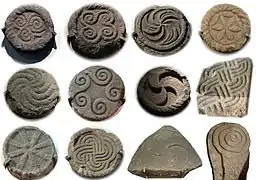Six-petal rosette
The six-petal rosette is a design with six-fold dihedral symmetry composed from six Vesica piscis lenses arranged radially around a central point, often shown enclosed in a circumference of another six lenses.

The design is found as a rosette ornament in artwork dating back to at least the Late Bronze Age.[1]
Construction
 |
| The seven overlapping circles grid forms a triangular lattice, seen here with hexagonal rings of 1, 7, 19, 37, 61, 91 circles.[2] |
The pattern figure can be drawn by pen and compass, by creating seven interlinking circles of the same diameter touching the previous circle's center. The second circle is centered at any point on the first circle. All following circles are centered on the intersection of two other circles.

The expansion of the design into a regular overlapping circles grid is also known as "Flower of Life". Bartfeld (2005) describes the construction: "This design consists of circles having a 1-[inch] radius, with each point of intersection serving as a new center. The design can be expanded ad infinitum depending upon the number of times the odd-numbered points are marked off."[3]
History and folk art
The design is attested from at least the beginning of the Late Bronze Age,[1] represented, for example, on ornamental golden disks found in Shaft Grave III at Mycenae (16th century BC).[4]
It is also found in some Cantabrian stelae, dated to the Iron Age. In ancient art, the ornament occurs alongside other patterns, such as eight-petal rosettes as well as arrangements of swirls or spirals, and the attribution of any kind of significance to its occurrence is purely speculative. Peralta Labrador (1989) cites a proposal according to which the design in the La Tène (Celtic) period was a solar symbol associated with the god Taranis.[5]
The six-petal rosette is common in the early modern (17th to 18th century) folk art of the Alpine region, in the Pyrenees (Cantabria, Navarre, Aragon), and parts of Eastern Europe.[6]
In Portugal, it is common to find it in medieval churches and cathedrals, as the engraved signature of a mason; but also as decoration and symbol of protection on the chimneys of old houses in Alentejo (at times together with the lauburu, or with Solomon's pentagram).
The design is also known as "Sun of the Alps" (Sole delle Alpi) in Italy from its widespread use in alpine folk art.[7] It resembles a pattern often found in that area on buildings.[8] It is used in the coat of arms of Lecco Province. It has also been used as the emblem of Padanian nationalism in northern Italy since the 1990s. In 2001, Editoriale Nord, the publishing company of La Padania, registered the green-on-white design as a trademark.[9]
Gallery
 Ornamented gold disks from Shaft Grave III at Mycenae (16th century BC), Archaeological Museum, Istanbul.
Ornamented gold disks from Shaft Grave III at Mycenae (16th century BC), Archaeological Museum, Istanbul. Roman-era mosaic (2nd century), Domus dell'Ortaglia, Brescia
Roman-era mosaic (2nd century), Domus dell'Ortaglia, Brescia Cantabrian stele at the Monastery of Iranzu, Navarre
Cantabrian stele at the Monastery of Iranzu, Navarre Selection of carvings from the hillfort of Santa Trega, Galicia (La Tène period, c. 1st century BC)
Selection of carvings from the hillfort of Santa Trega, Galicia (La Tène period, c. 1st century BC) Facade of the medieval church in Galdo degli Alburni, Province of Salerno
Facade of the medieval church in Galdo degli Alburni, Province of Salerno Facade of the church in San Domenico, Lucera, Province of Foggia (ca. 1300)
Facade of the church in San Domenico, Lucera, Province of Foggia (ca. 1300) ceiling beam displayed at the Rural Architecture Museum of Sanok (Poland) dated to 1681.
ceiling beam displayed at the Rural Architecture Museum of Sanok (Poland) dated to 1681..jpg.webp) Masonry in casa Federici, Erbanno, Val Camonica
Masonry in casa Federici, Erbanno, Val Camonica Wall painting on the facade of farmhouse Runcata in St. Ulrich in Gröden, Ortisei, Val Gardena, South Tyrol
Wall painting on the facade of farmhouse Runcata in St. Ulrich in Gröden, Ortisei, Val Gardena, South Tyrol Green-on-white "Sun of the Alps" as used by the Lega Nord and in Padanian nationalism
Green-on-white "Sun of the Alps" as used by the Lega Nord and in Padanian nationalism
See also
| Wikimedia Commons has media related to Flower of Life. |
References
- Høyrup, J. (2000). "Geometrical Patterns in the Pre-classical Greek Area. Prospecting the Borderland between Decoration, Art, and Structural Inquiry" (PDF). Revue d'histoire des mathématiques. 6 (1): 5–58.
- Islamic Art and Geometric Design: Activities for Learning
- Bartfeld, Martha (2005). How to Create Sacred Geometry Mandalas. Santa Fe, NM: Mandalart Creations. p. 35., citing Drunvalo Melchizedek, The Ancient Secret of the Flower of Life (1999). The attribution of the term "Flower of Life" to Melchizedek (1999) is also found in Wolfram, Stephen (May 14, 2002), A New Kind of Science, Wolfram Media, Inc., pp. 43 and 873–874, ISBN 1-57955-008-8 and in Weisstein, Eric W. (2002), CRC Concise Encyclopedia of Mathematics, Second Edition, CRC Press, p. 1079, ISBN 1420035223.
- Excavated by Heinrich Schliemann in 1876. Schliemann, Mykenae (1878), pp. 165–172.
- Eduardo Peralta Labrador, Las estelas discoideas de Cantabria in: Estelas discoideas de la Peninsula Iberica (1989), pp 425–466, citing the opinion of José María Blázquez Martínez.
- Ariel Golan, Prehistoric Religion: Mythology, Symbolism, (2003), p. 54.
- "Il significato del simbolo del Sole delle Alpi" (in Italian). Lega Nord. Archived from the original on January 12, 2014. Retrieved December 1, 2014.
- Ivano Dorboló (June 6, 2010). "The church of S.Egidio and the Sun of the Alps symbol". Storia di Confine – Valli di Natisone. Retrieved November 9, 2015.
- Ufficio Italiano Brevetti e Marchi, registrazione del simbolo del Sole delle Alpi. According to Rosanna Sapori of Radio Padania Libera, the trademark as of August 2010 was owned by Silvio Berlusconi, who would have obtained it in exchange for the bailout of the bankrupt Credieuronord bank «Vi racconto perché Bossi è prigioniero di Berlusconi» Il Riformista 28 August 2010.